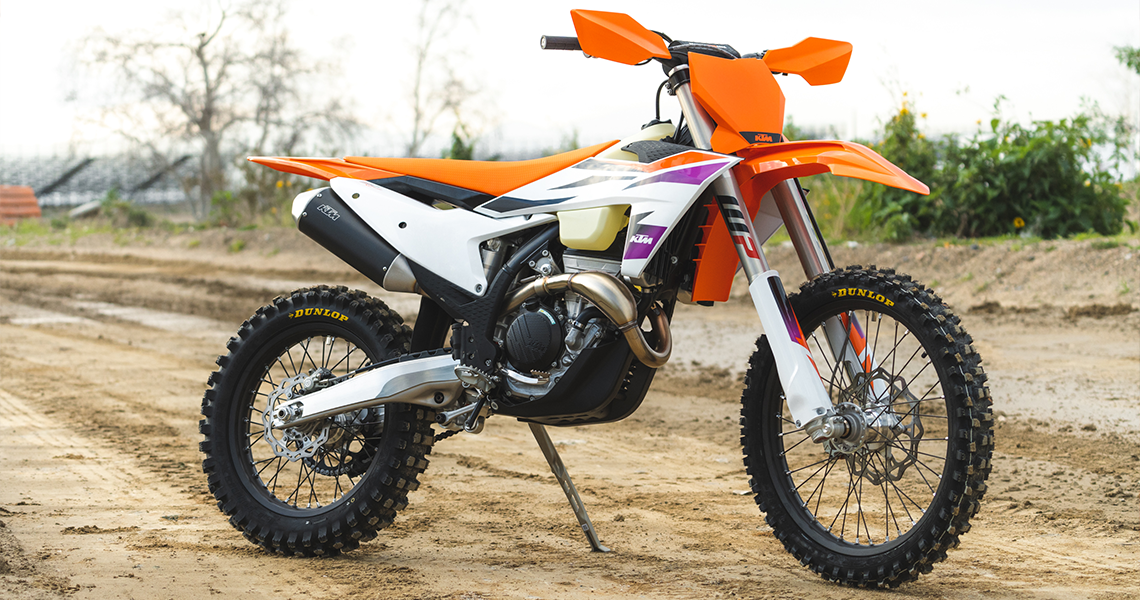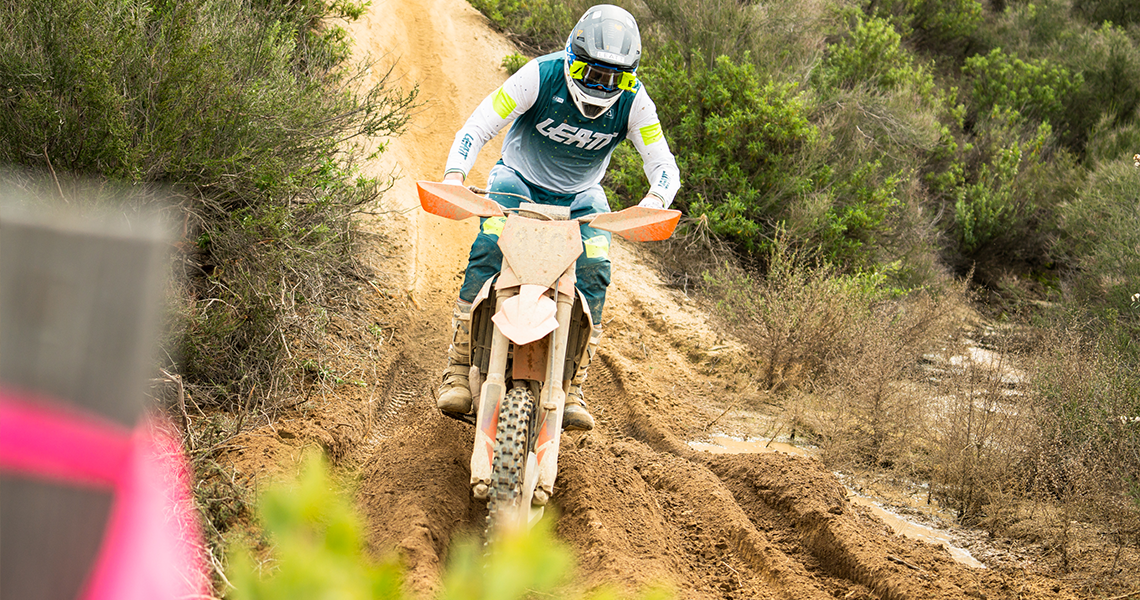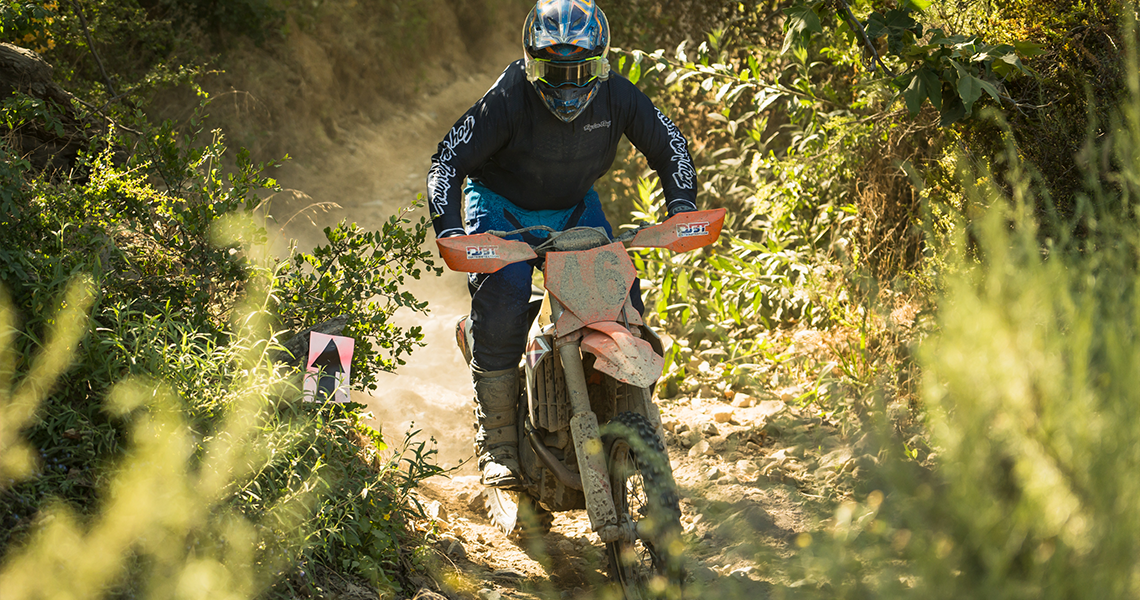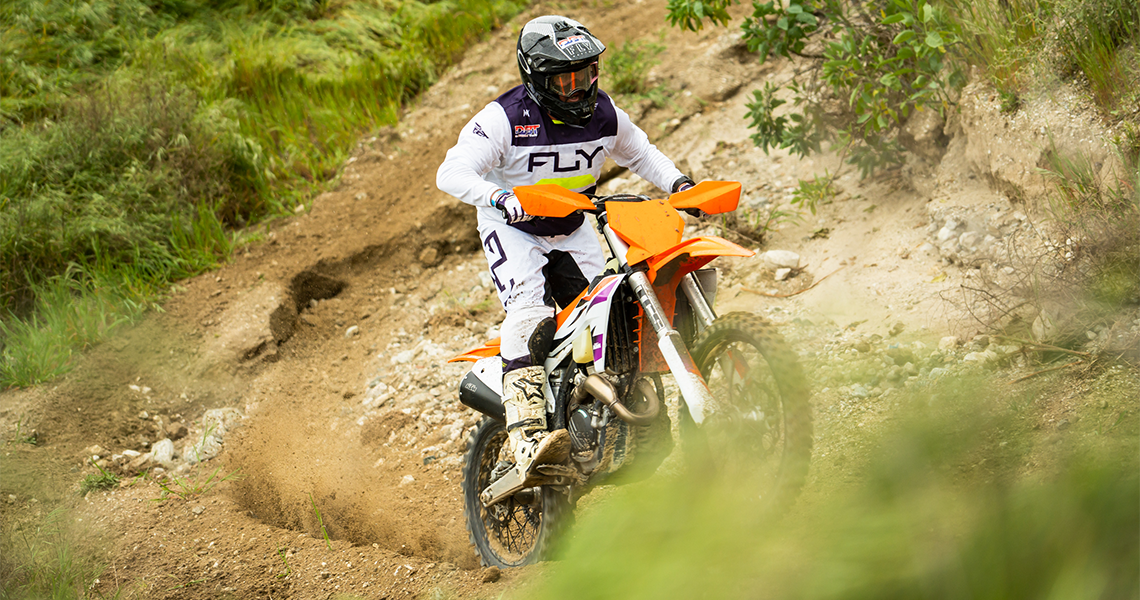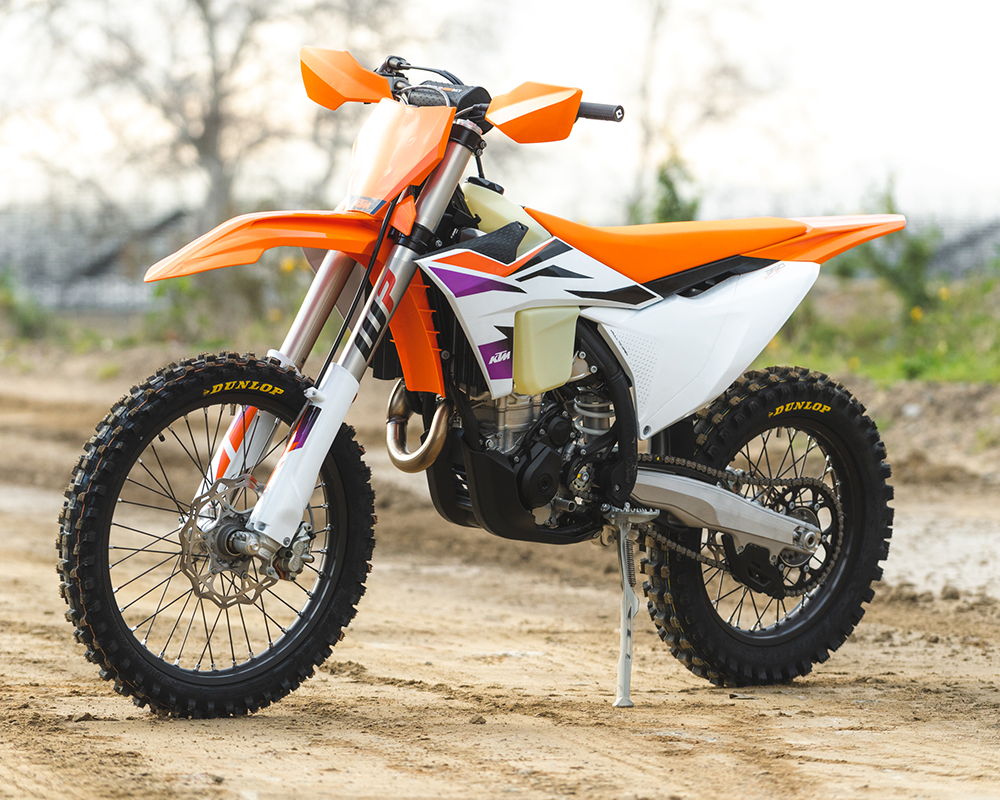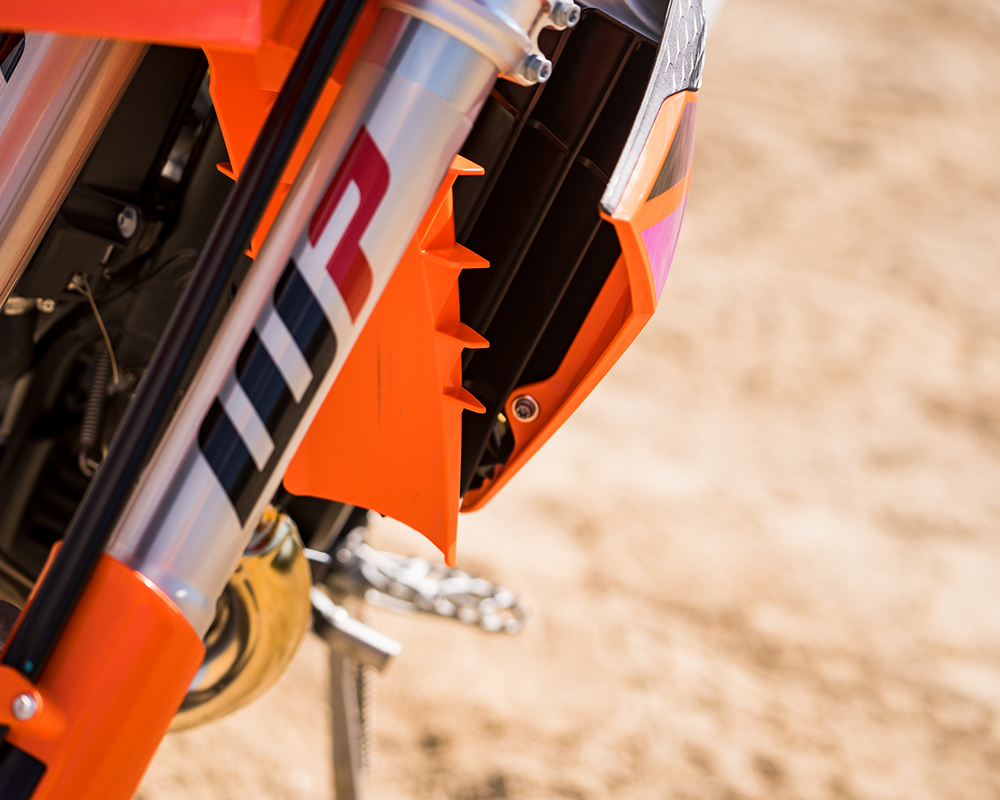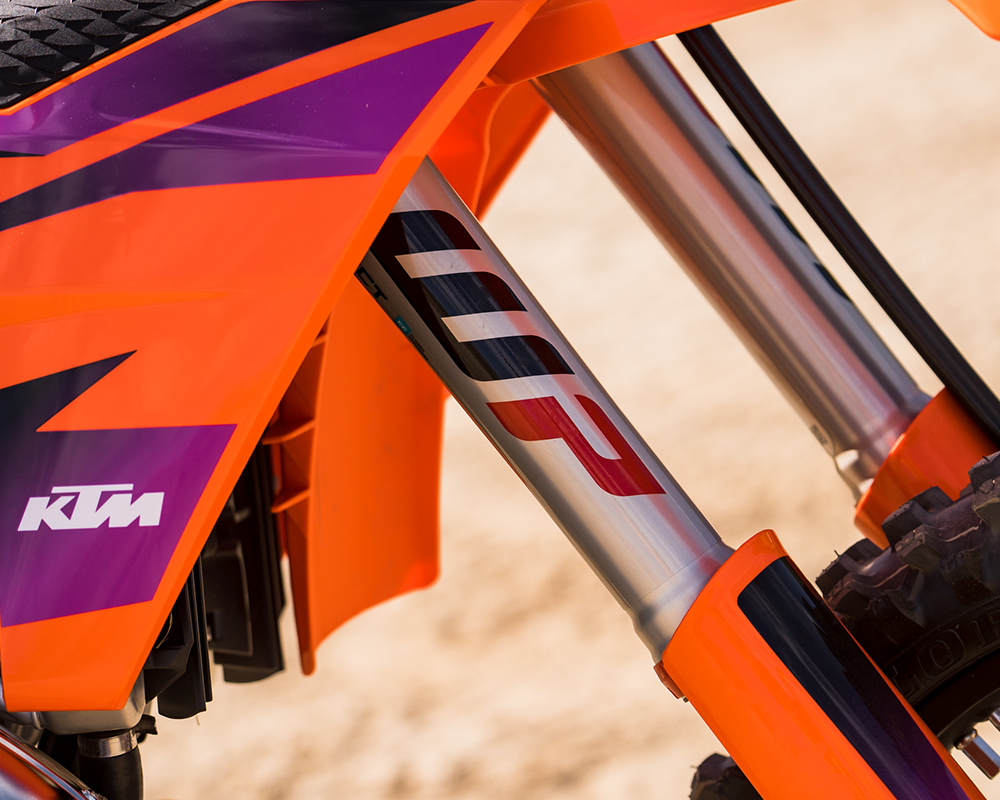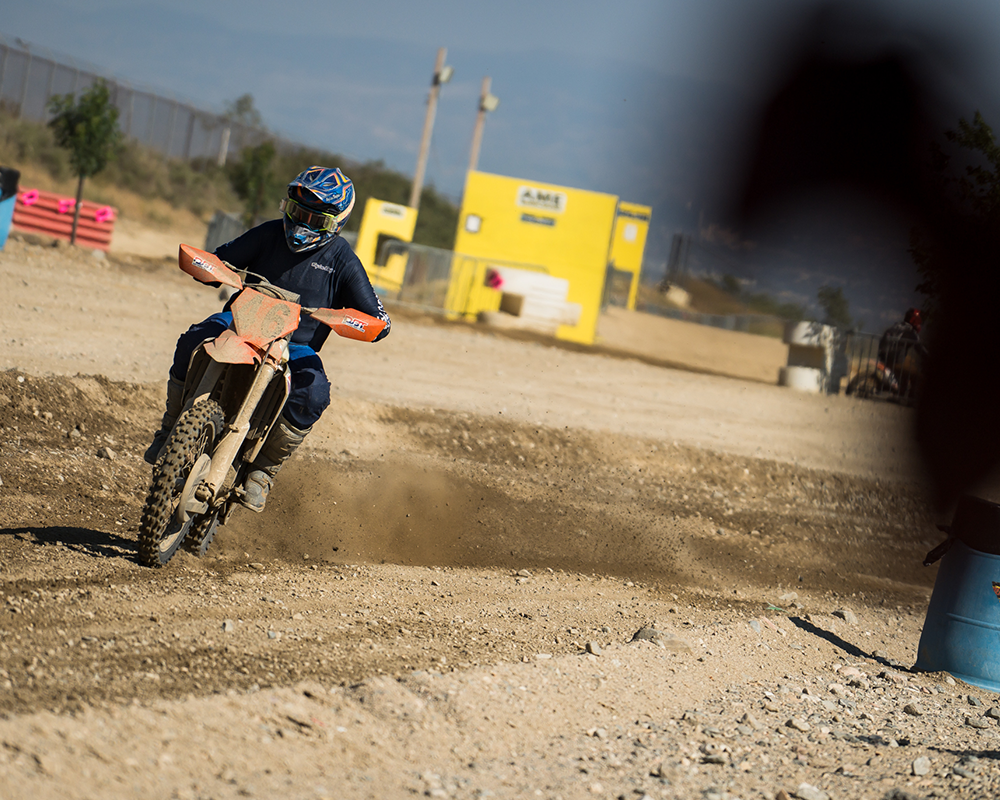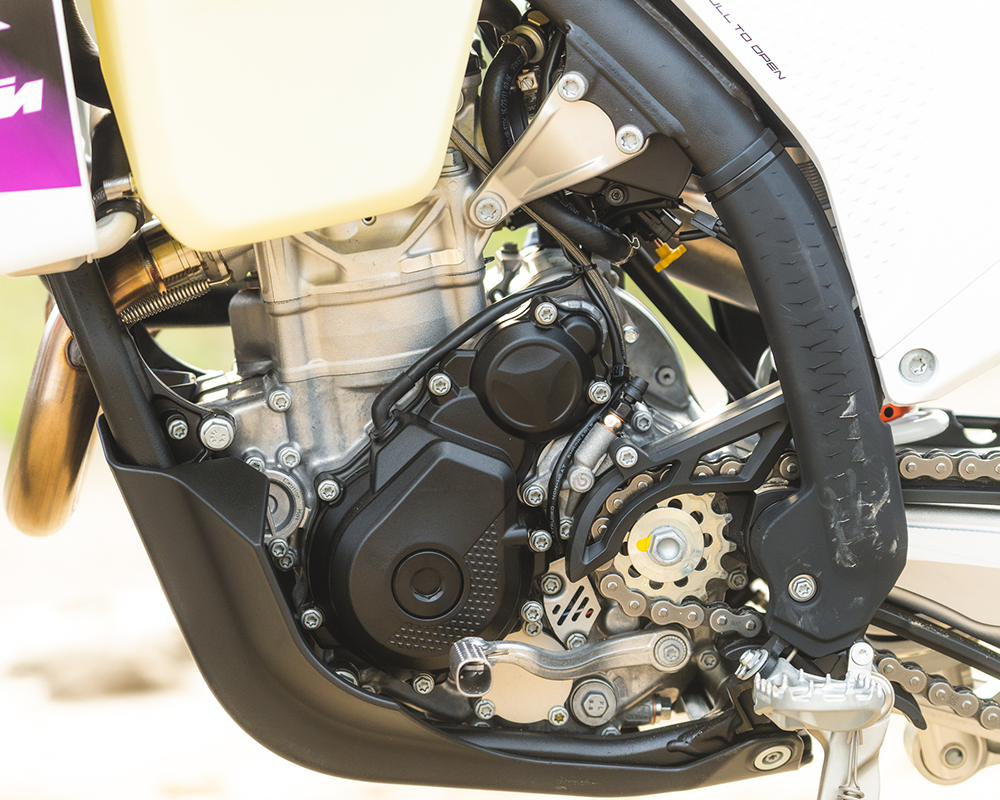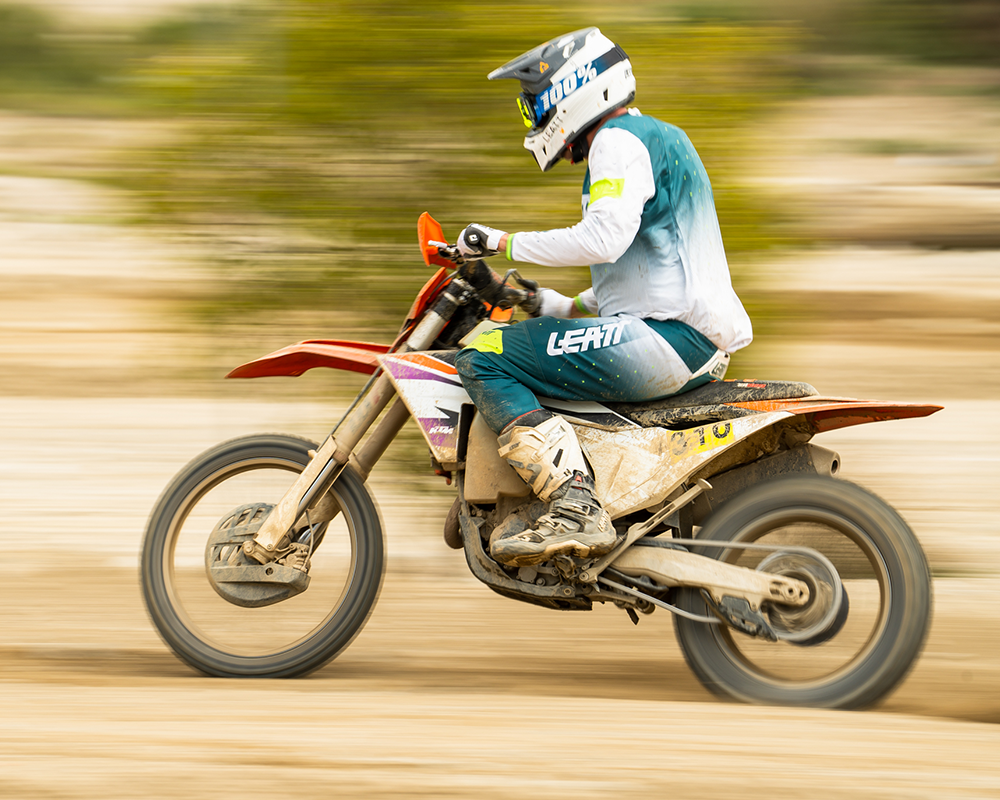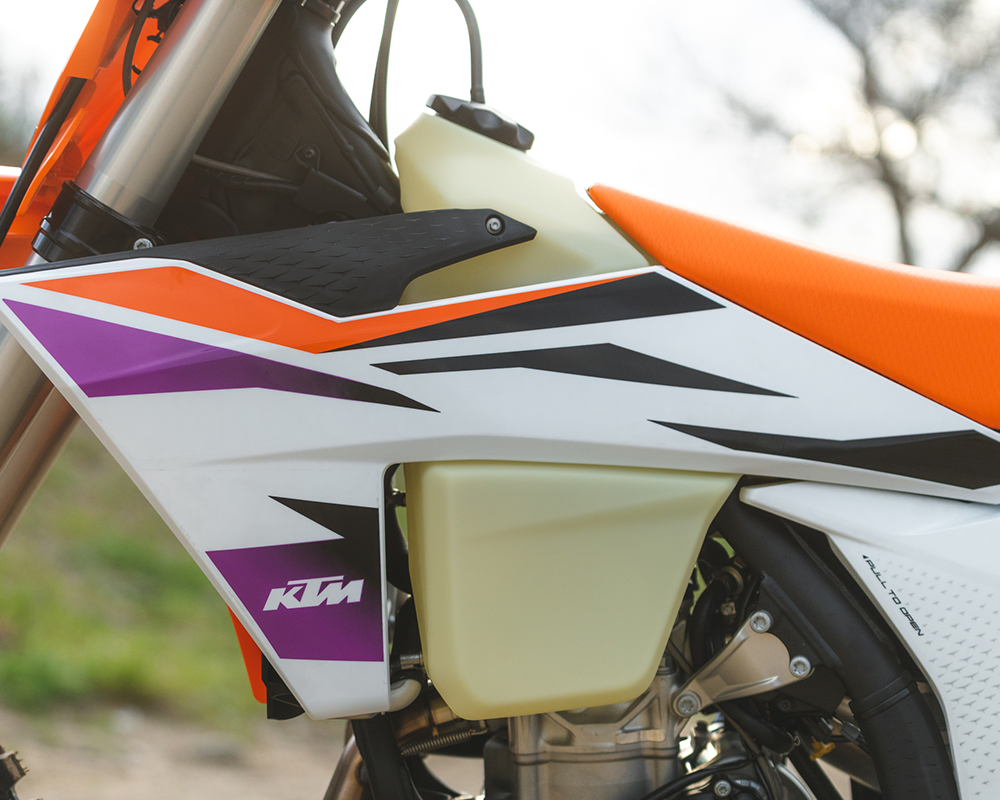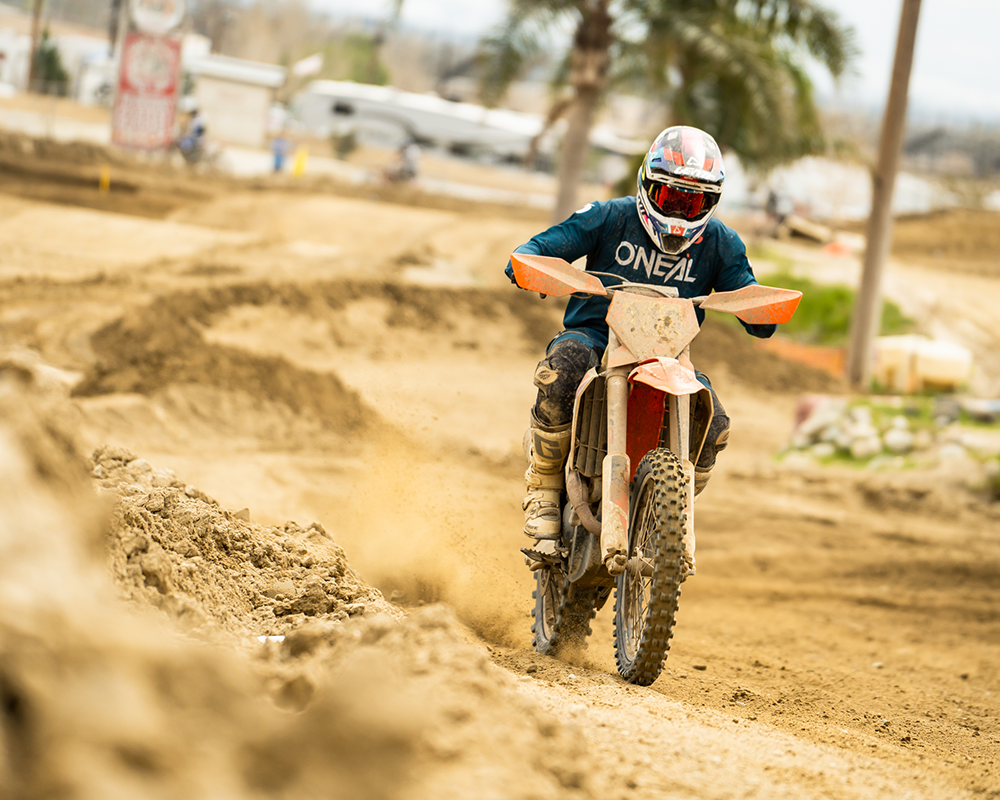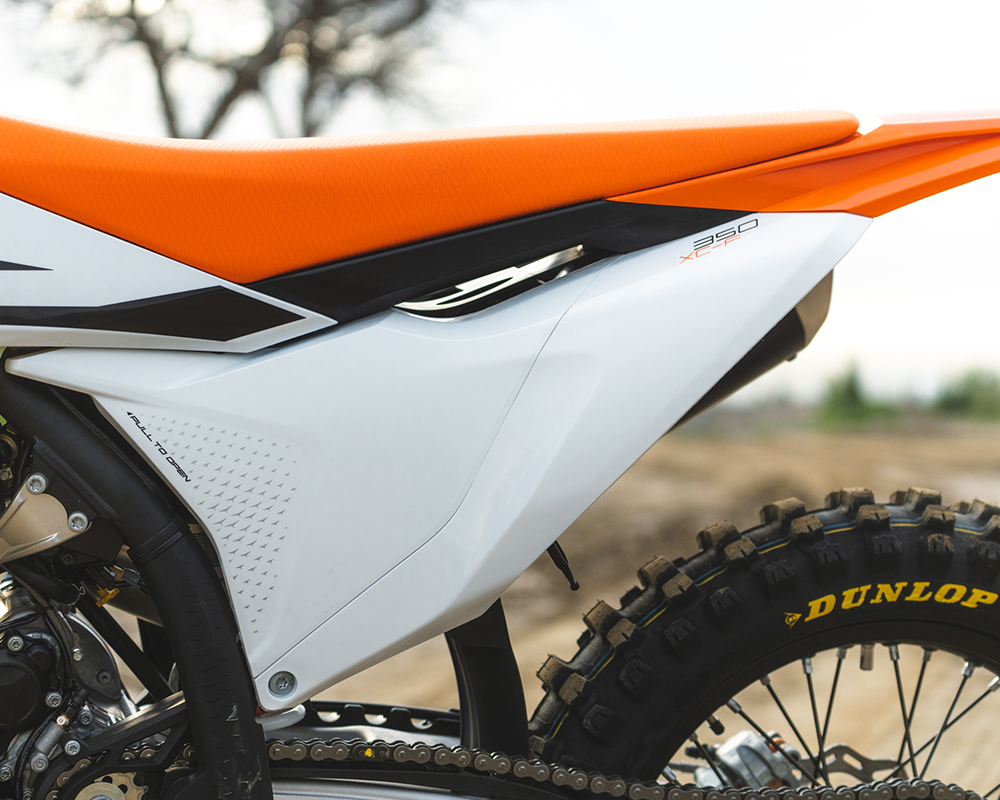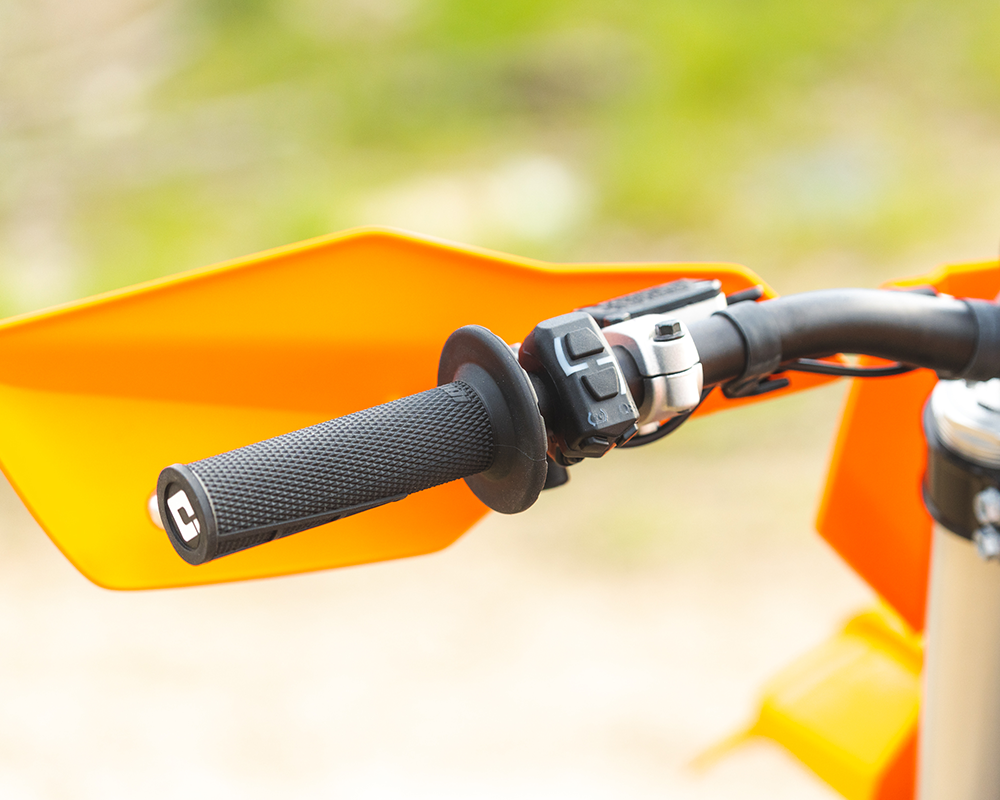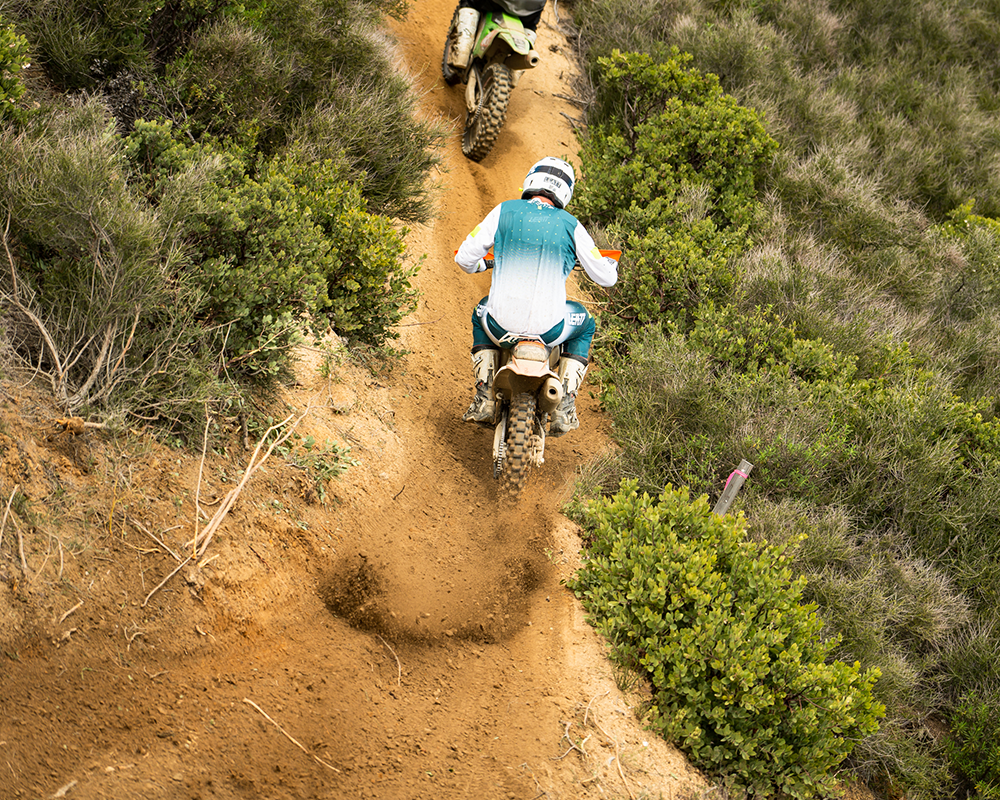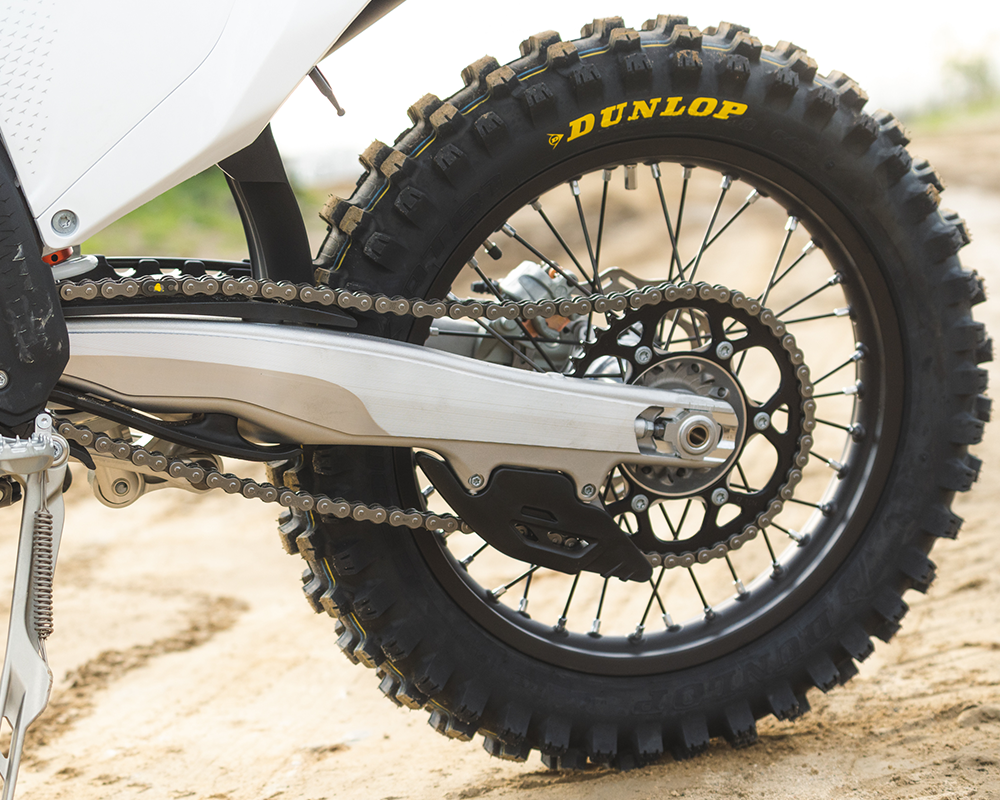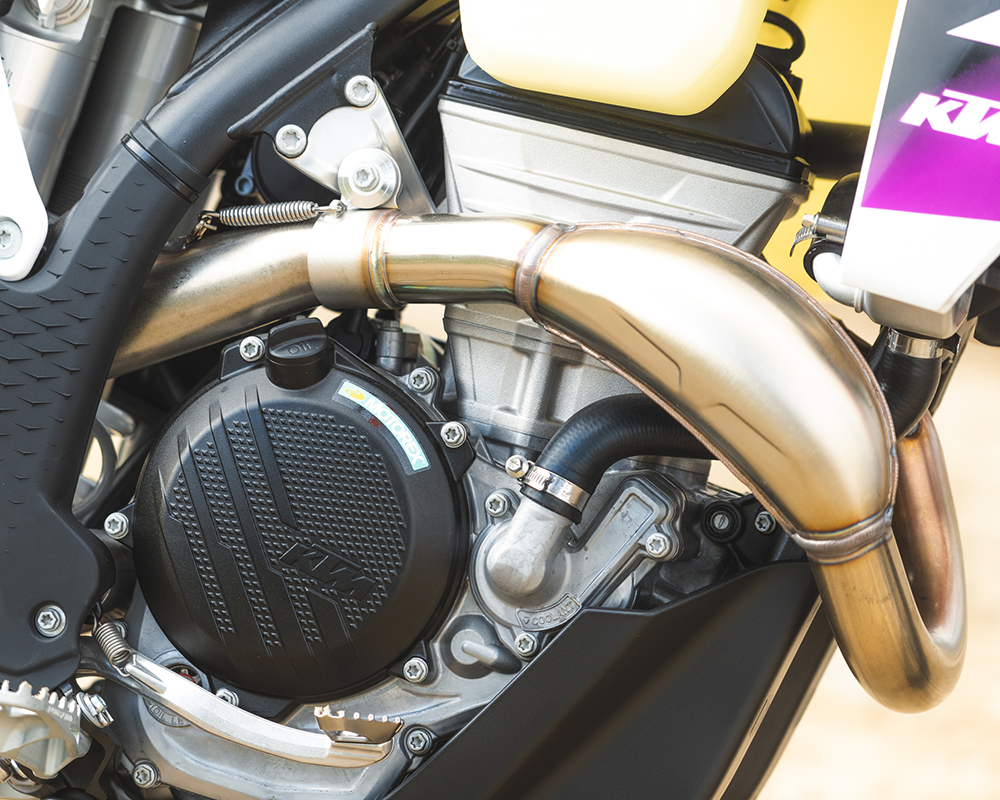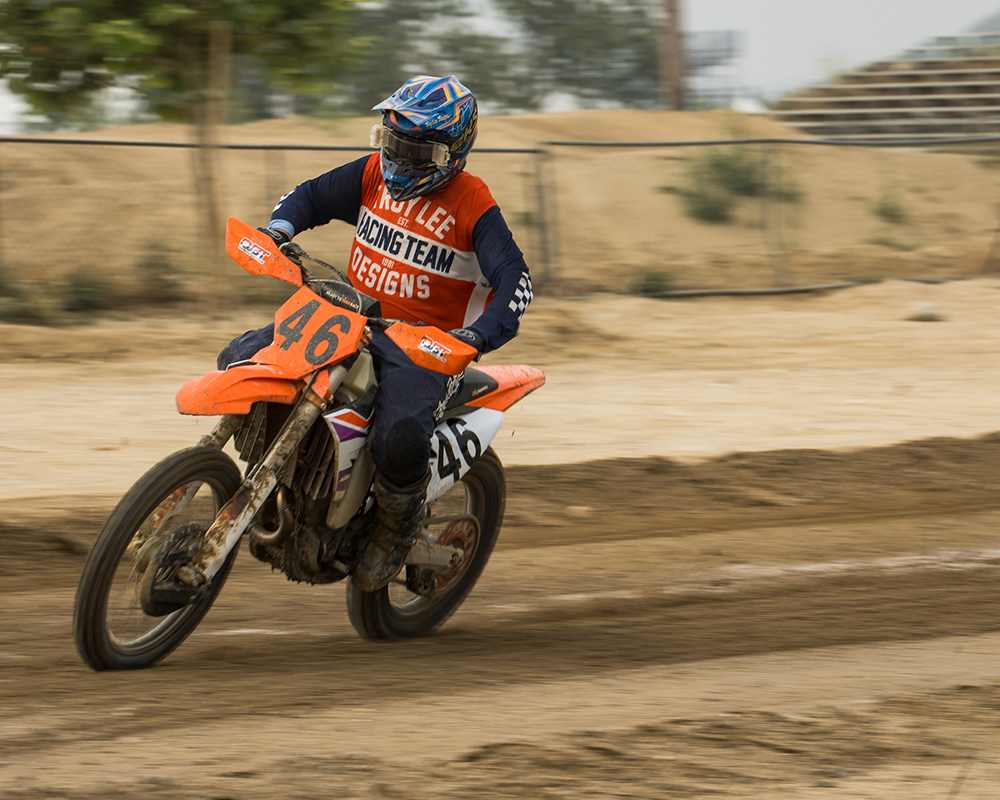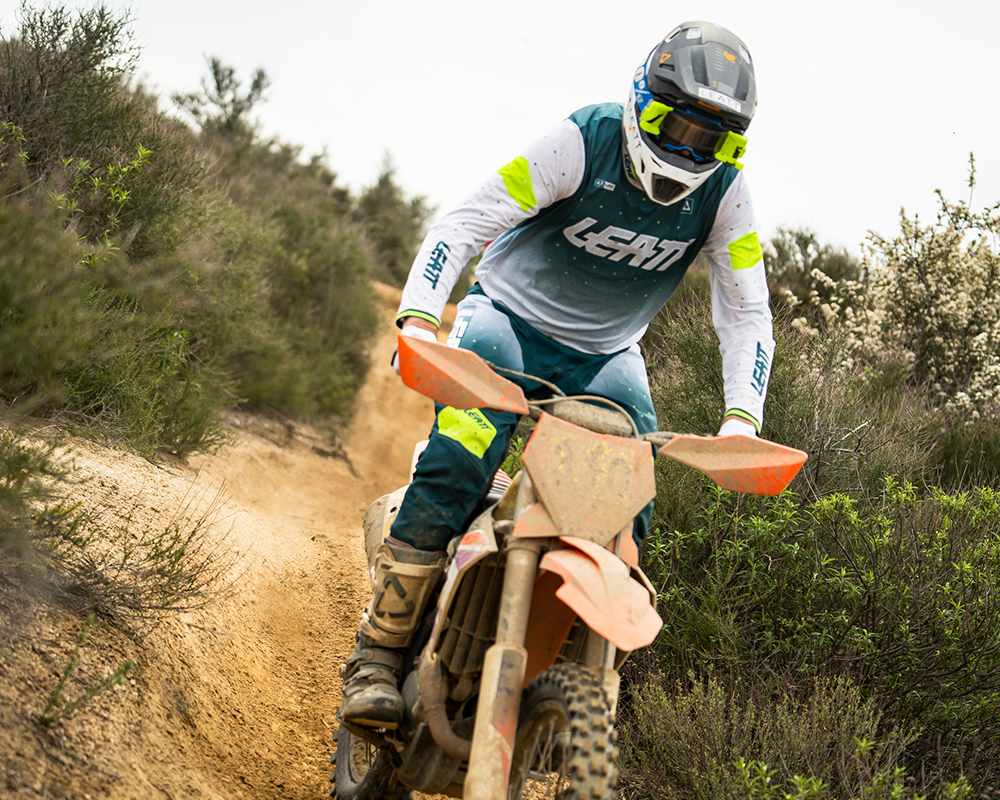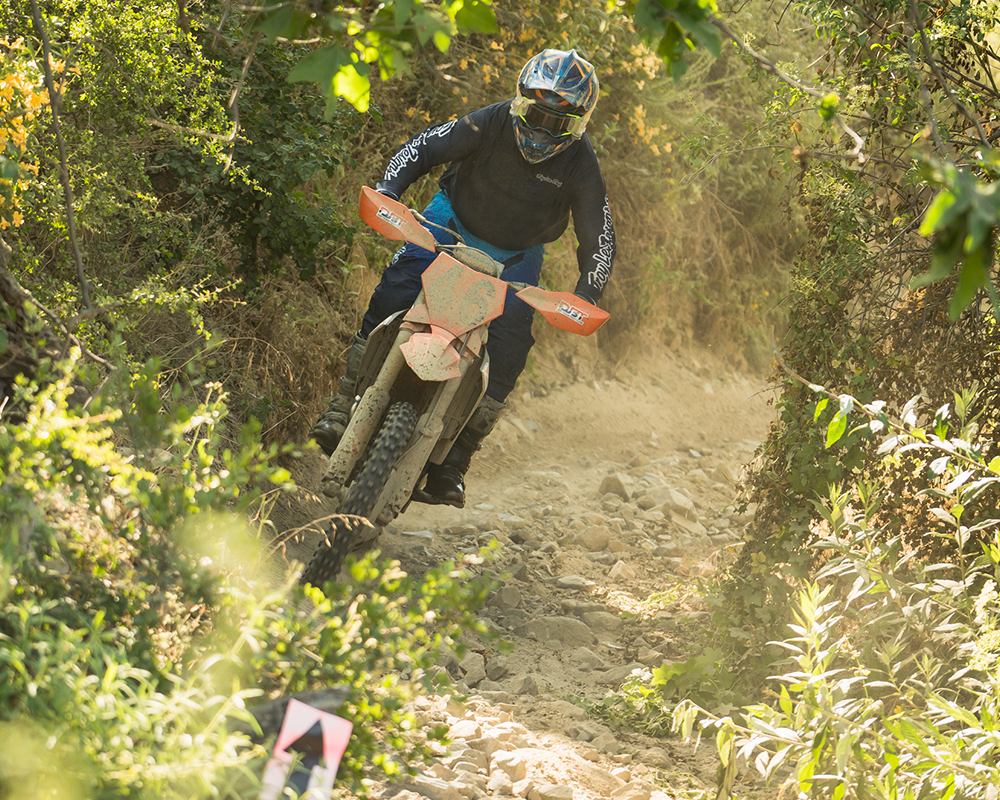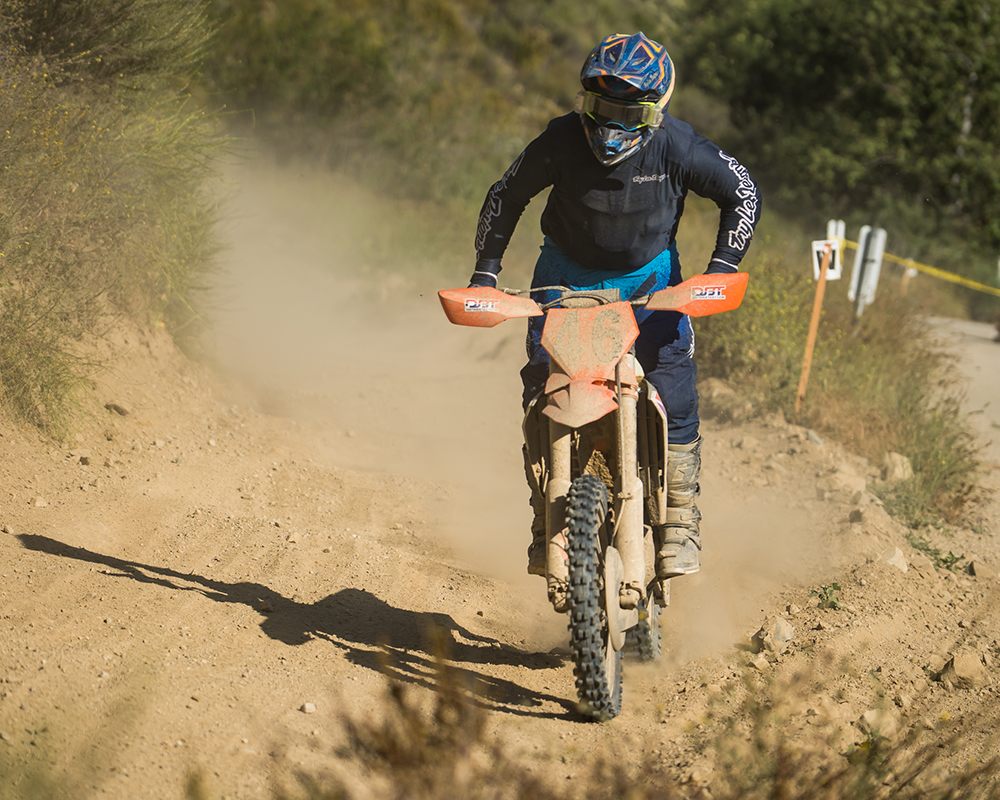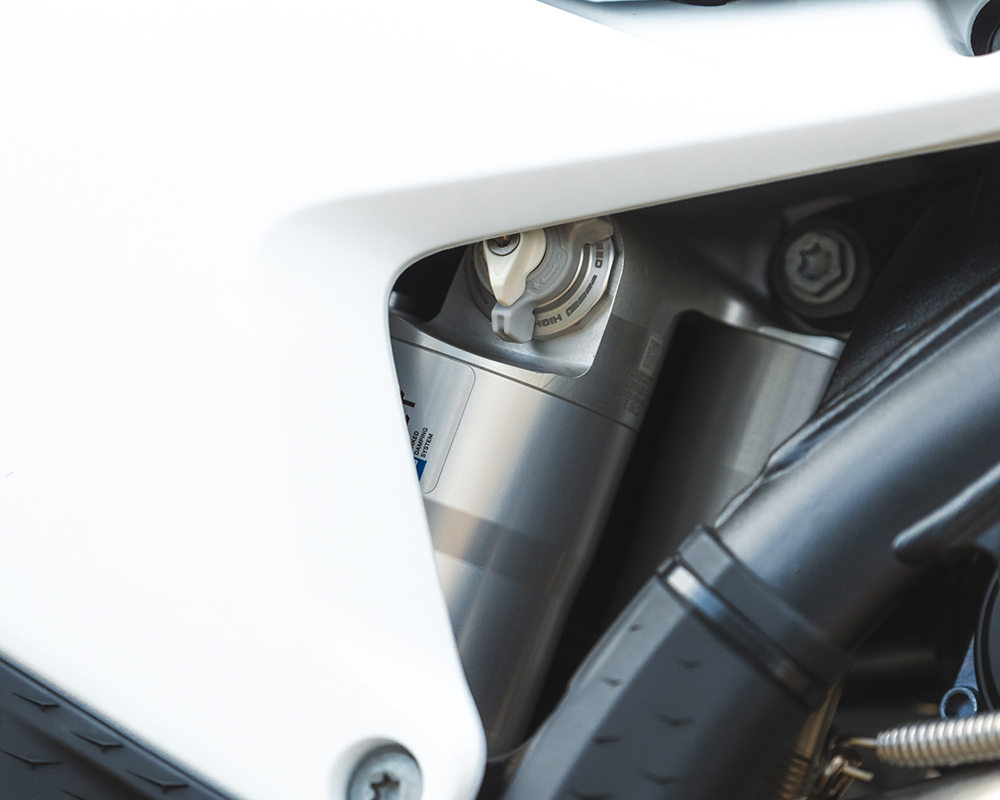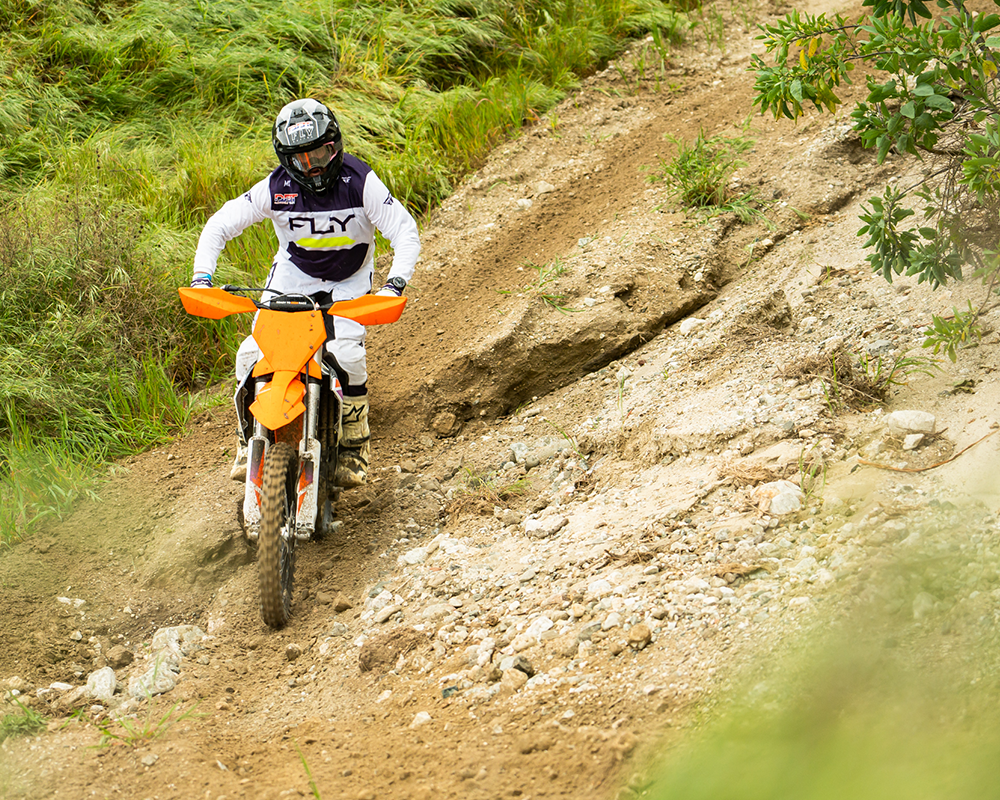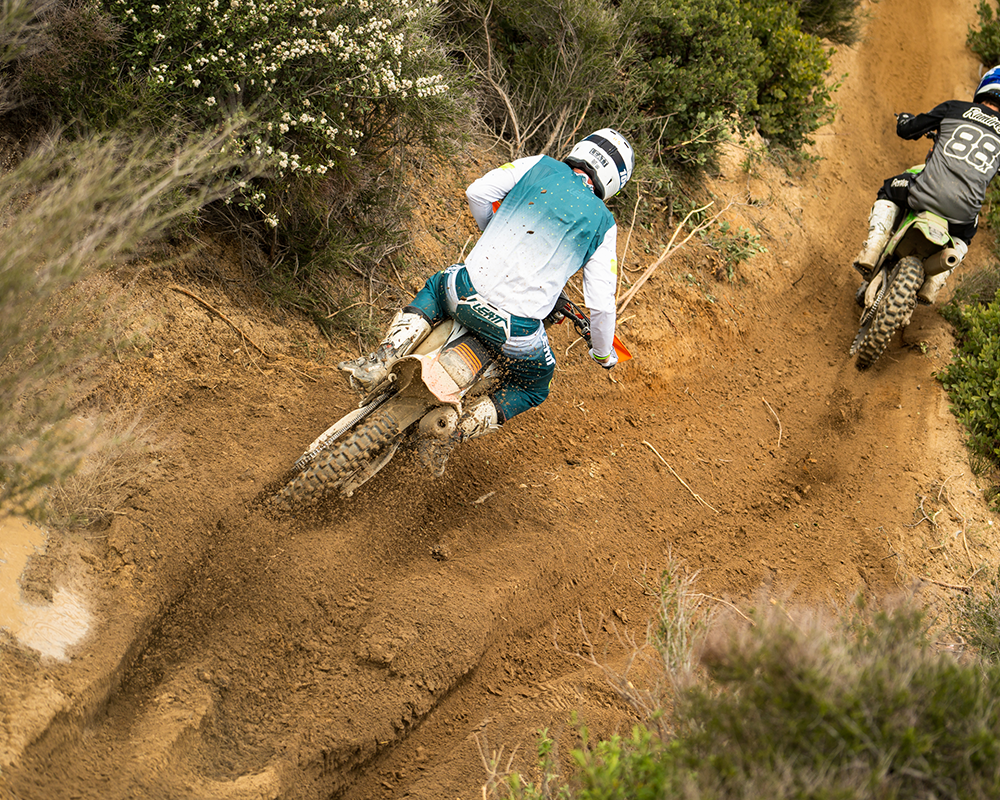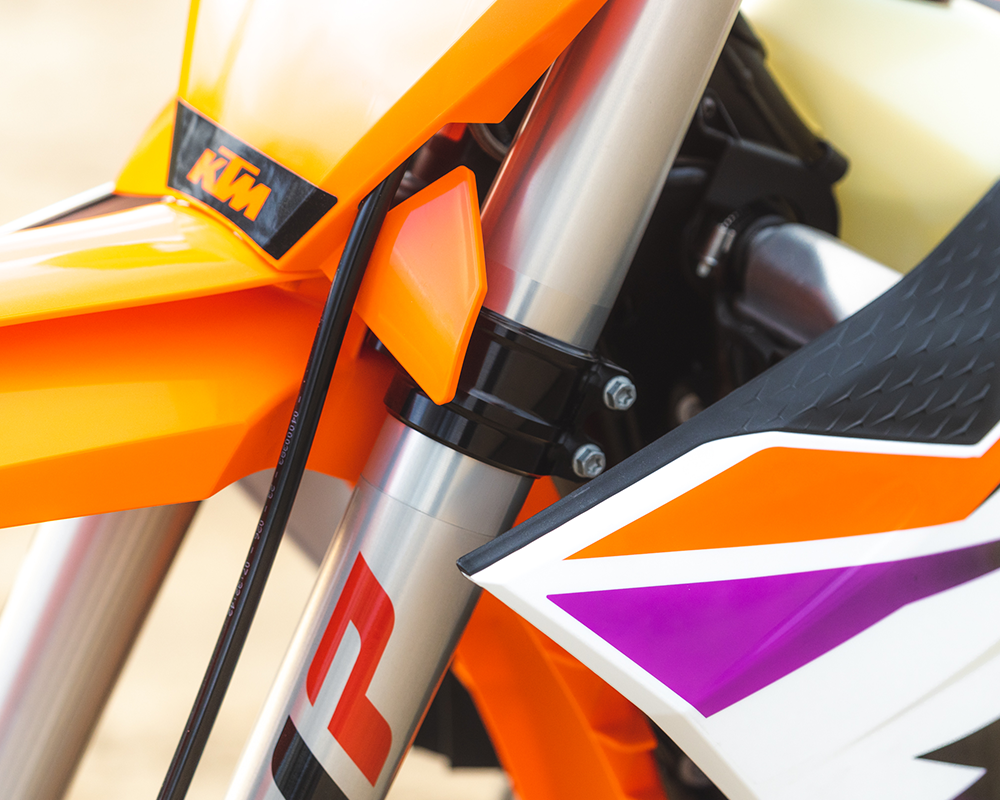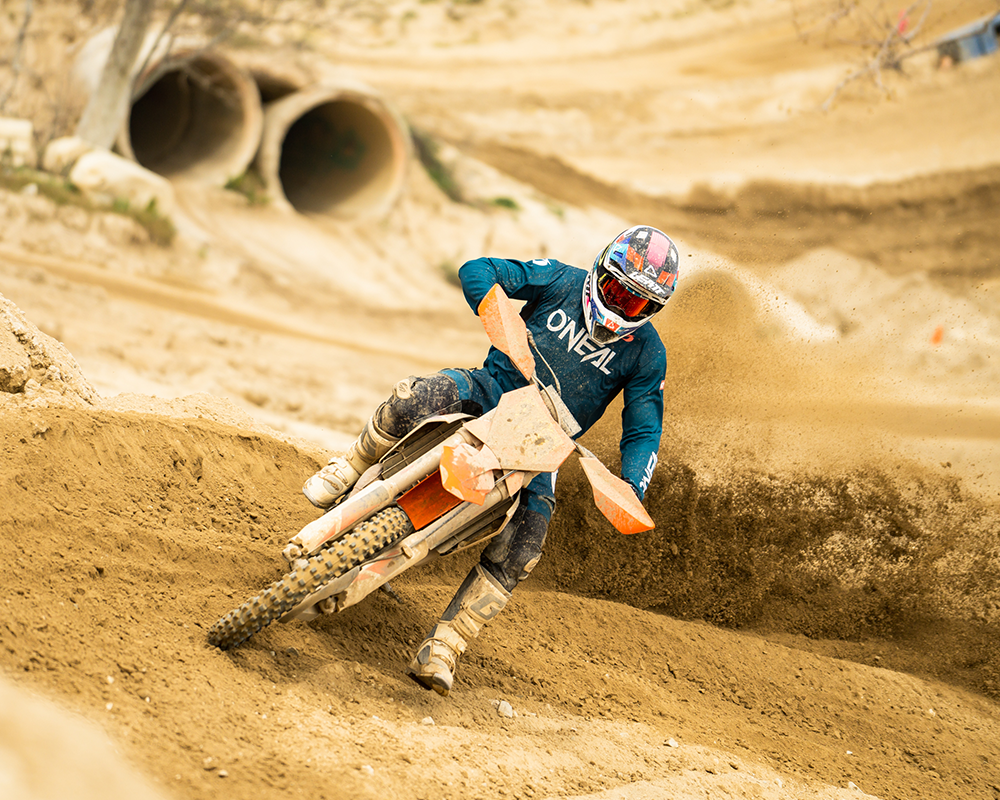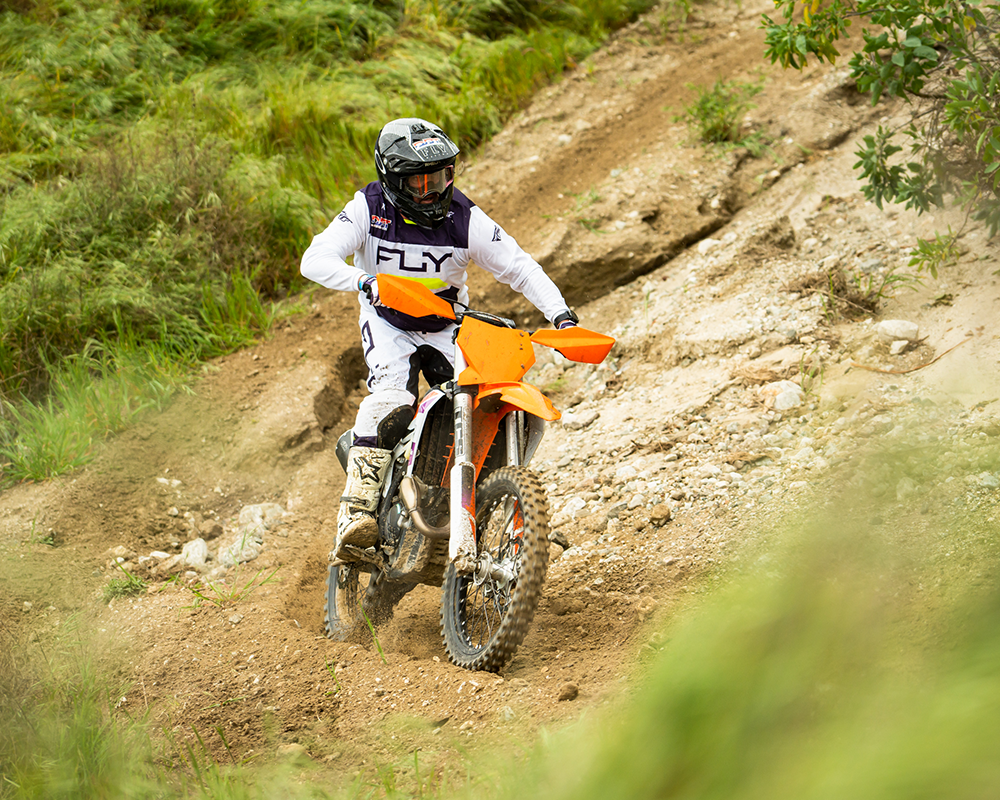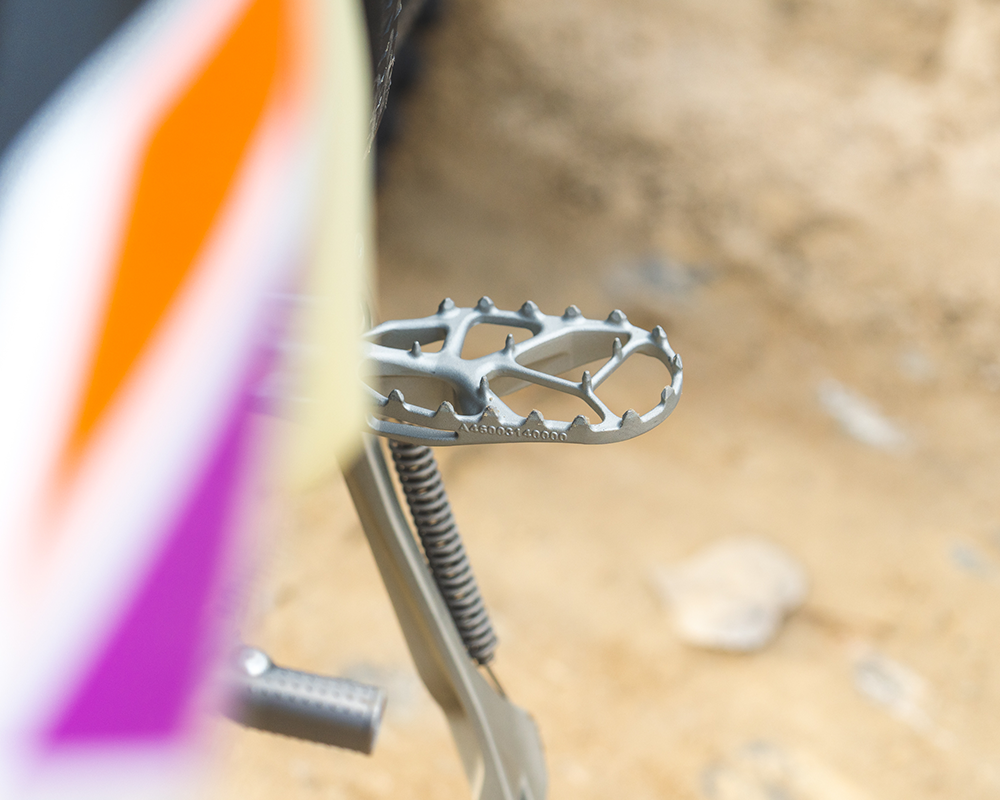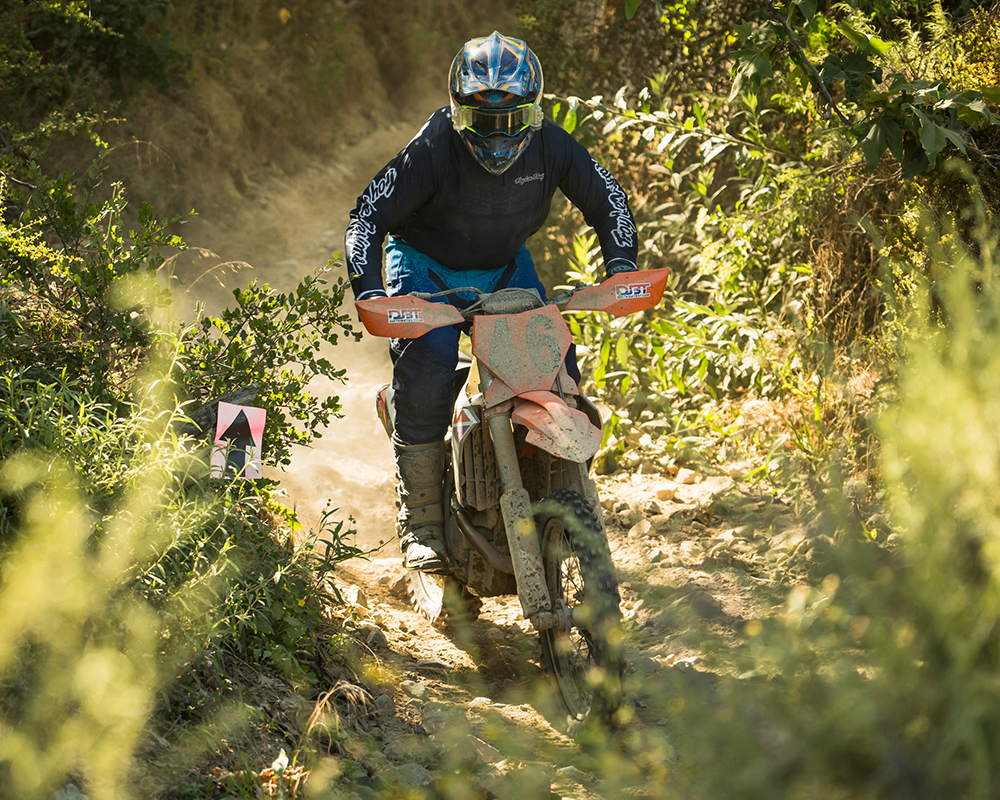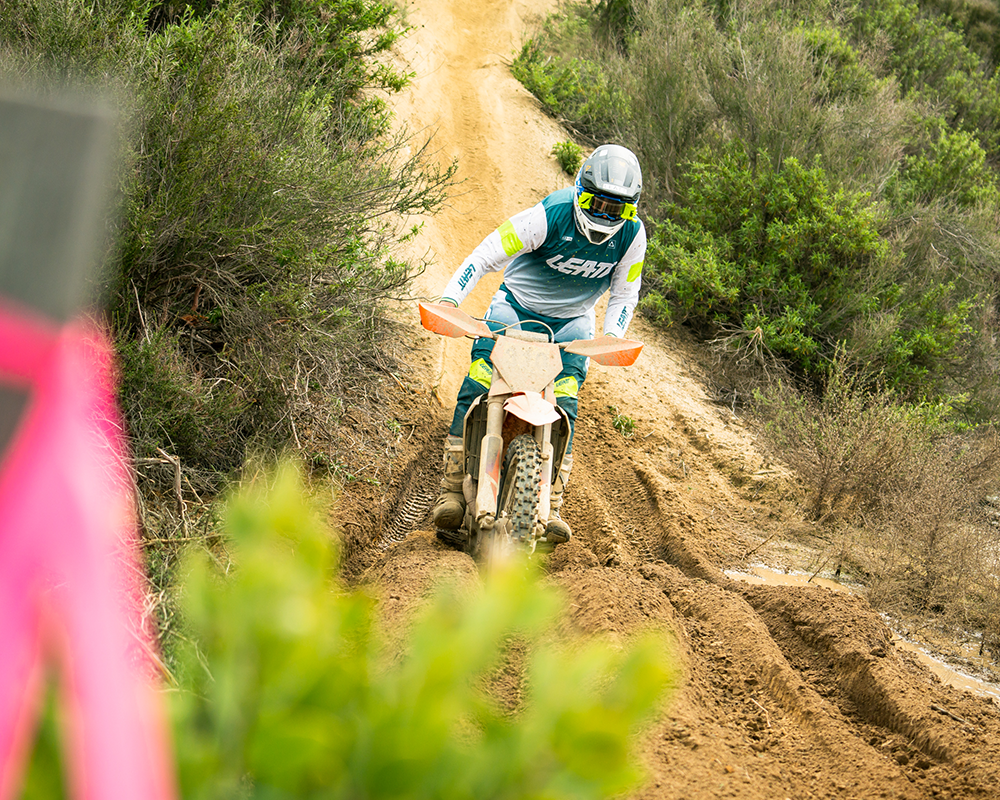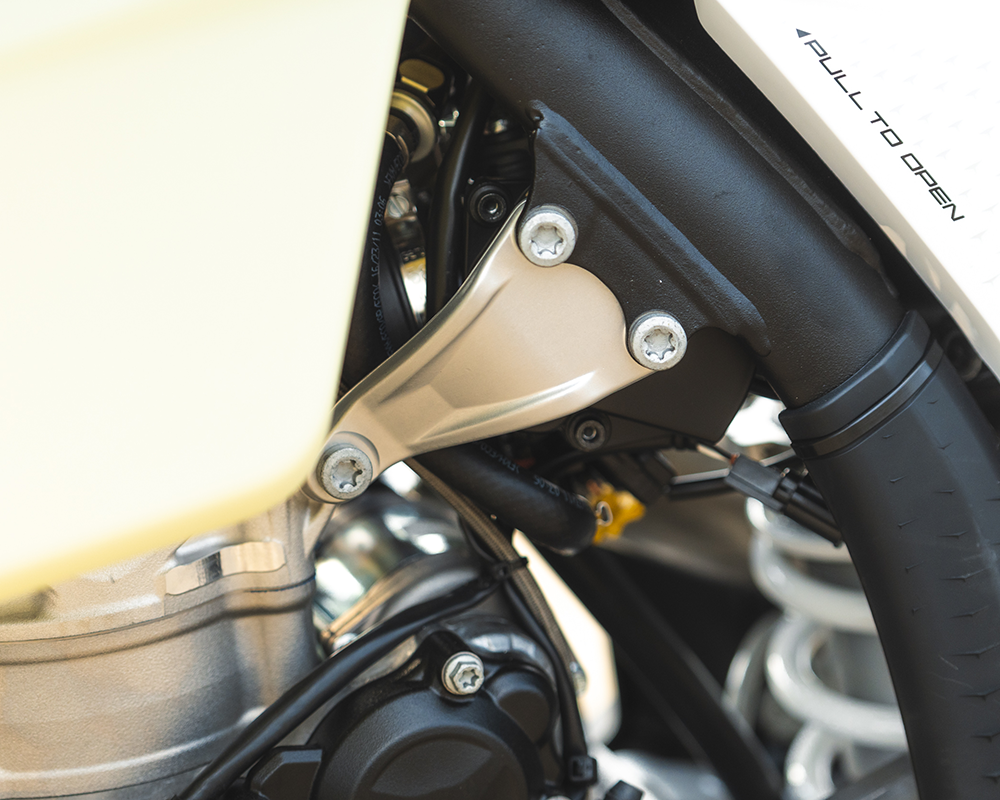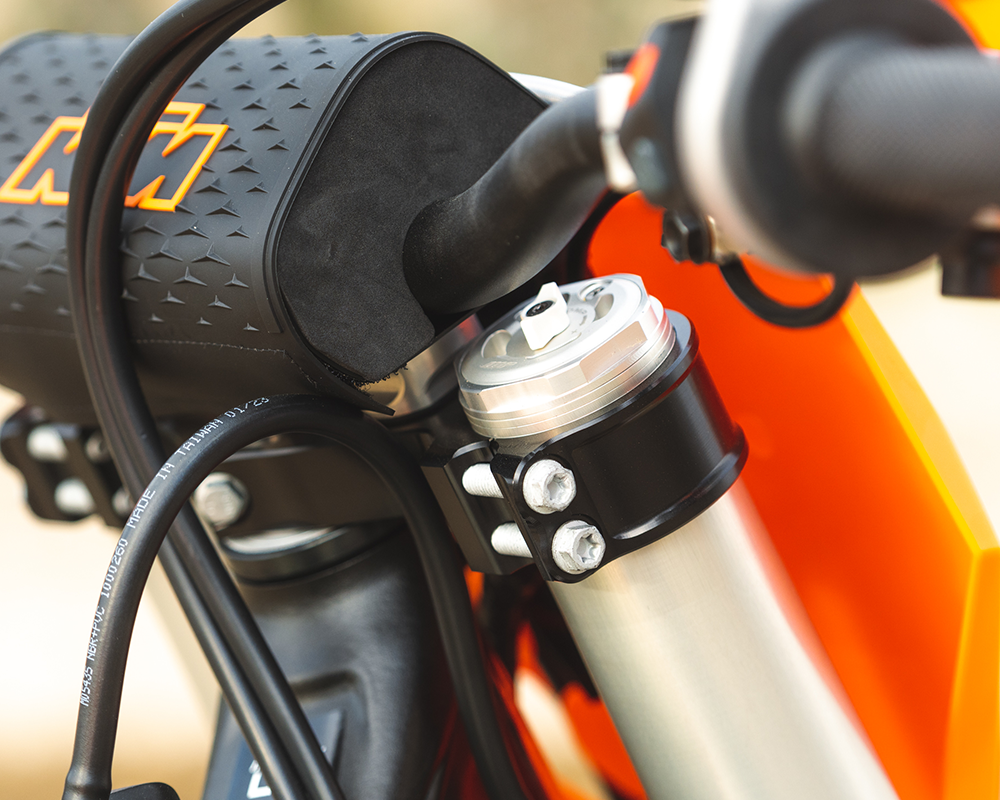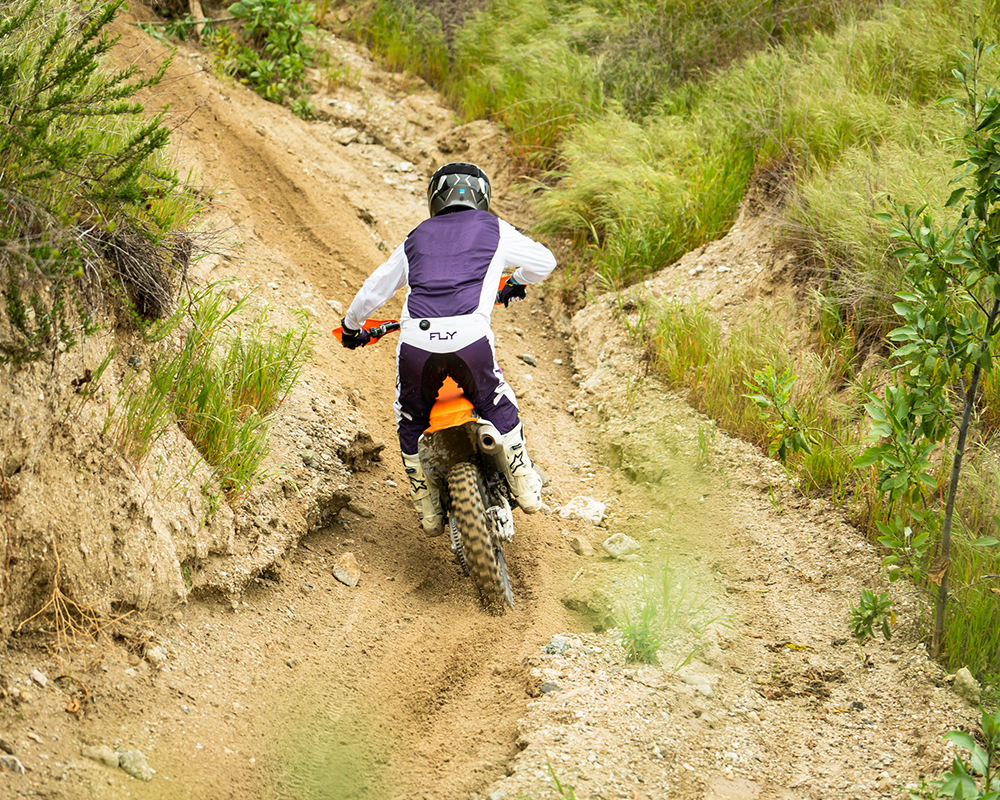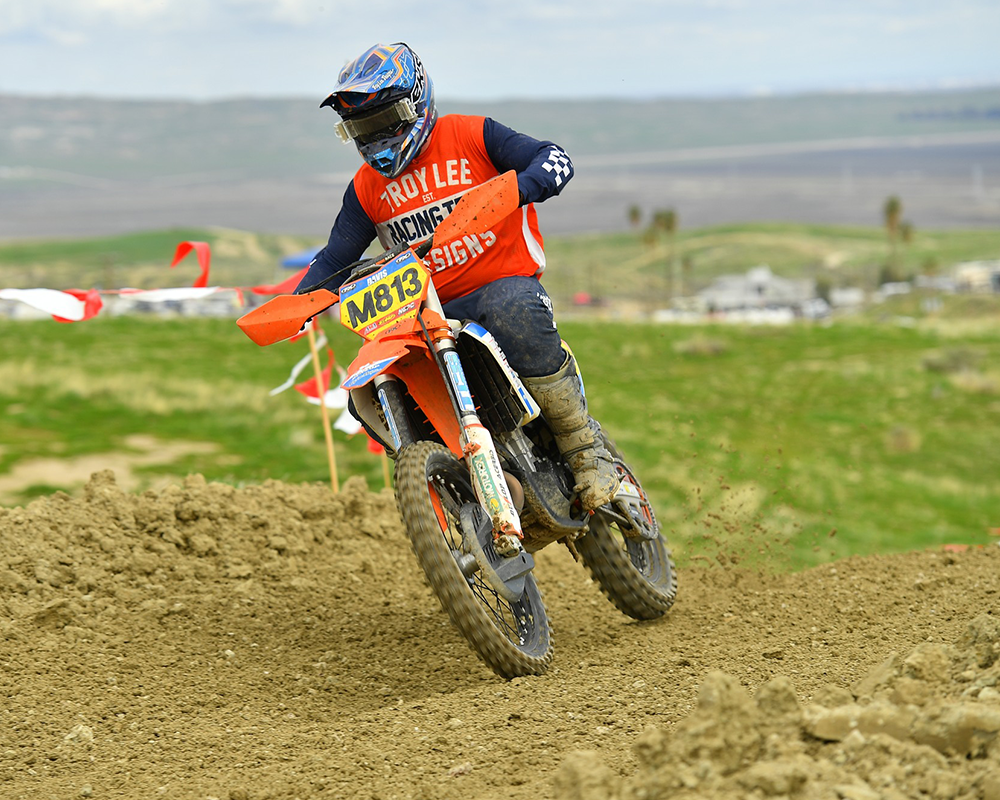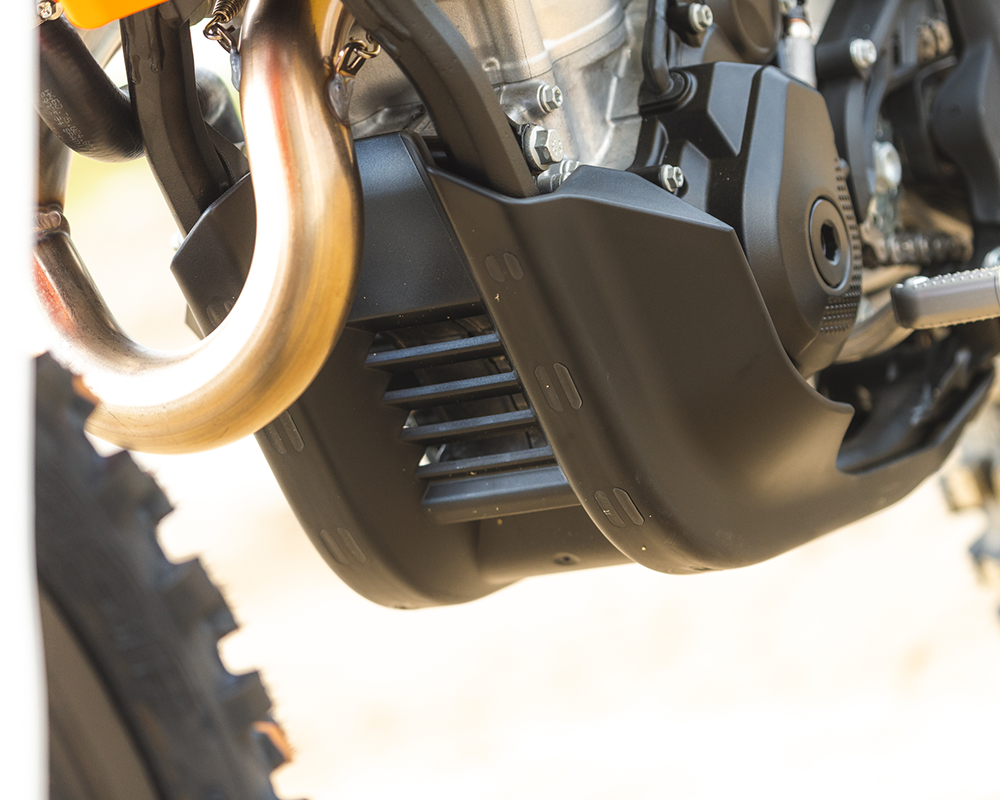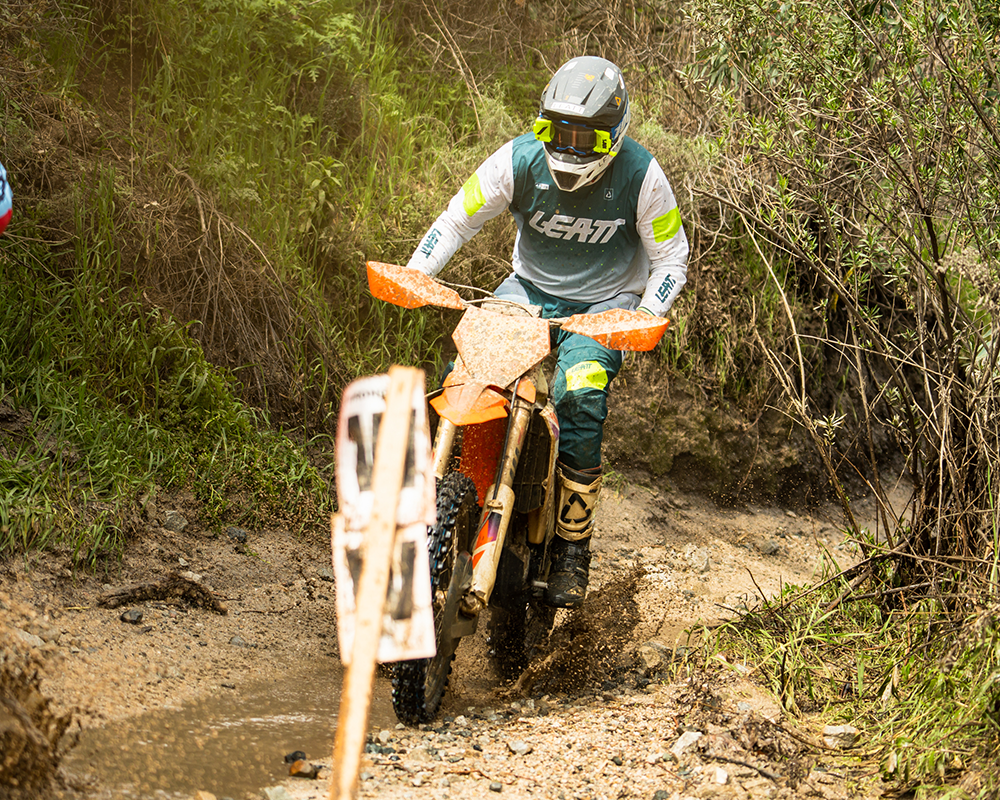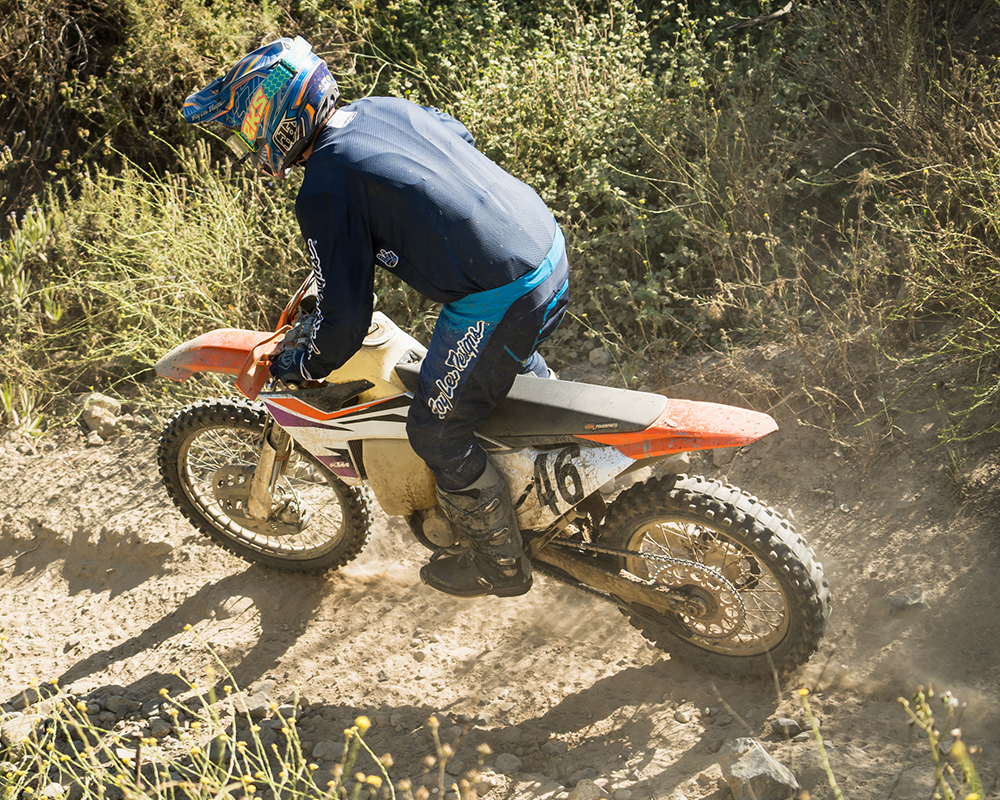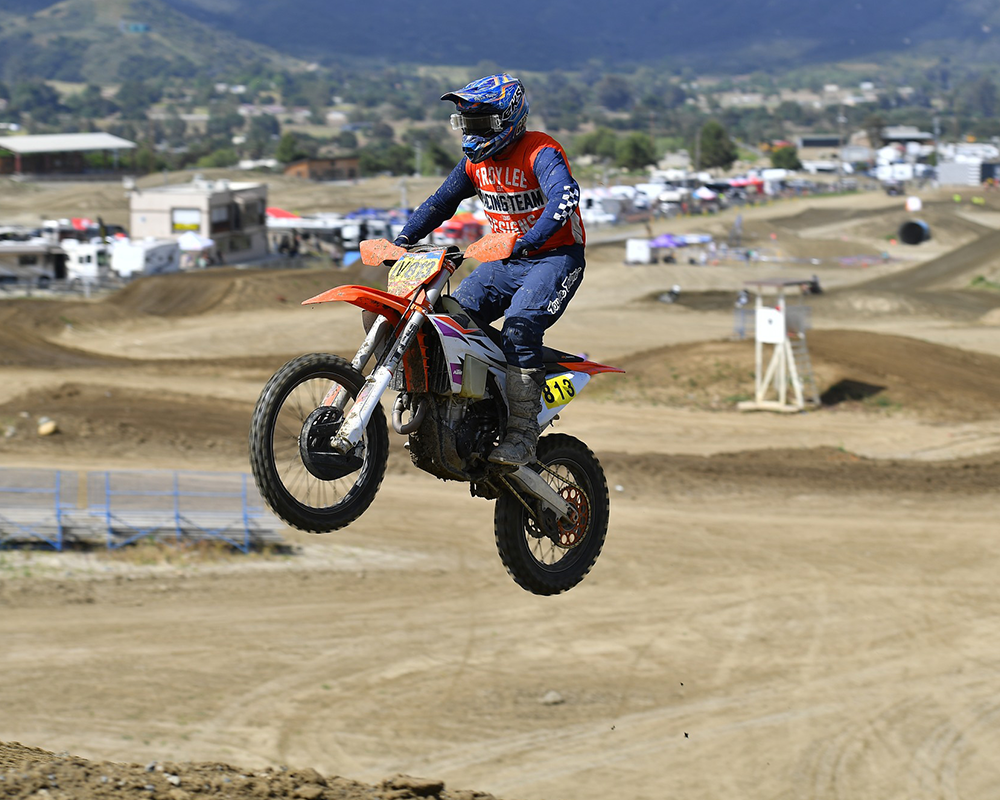2024 KTM 350 XC-F
The Swiss Army Knife
MSRP: $11,649
- A sweet spot between a 250 and 450.
- Feels light and maneuverable.
- Engine doesn’t upset the chassis.
- Less torque than a 450.
- Not as easy to ride “lazy”.
- Stock suspension may be soft for some.
Introduction
- KTM's 350cc off-road race bike.
The 2024 350 XC-F is a mid-bore, closed-course off-road race bike. Primarily seen as an East Coast “woods” bike, the 350cc four-stroke displacement has come a long way over the past decade and has evolved into more of a jack-of-all-trades bike rather than a specialist bike. The added power and torque that KTM has introduced over the years still reaps a lot of the same benefits as 350cc four-strokes did of yesteryear, but brings in more versatility and is an easier transition for riders coming off of bigger 450’s.
Changes
- New WP XACT closed-cartridge spring fork.
For 2024, this is a refined model that shares a lot with the 2023 edition which brought more substantial change. The most notable change is the move to a new WP closed cartridge spring fork which has fueled the air vs spring discussions even more than in past years. For our group of test riders, asking which they prefer is like asking which helmet is the best. Everyone has an opinion, and none of them are wrong. While many of our riders have been comfortable with the air fork, the move to the spring, if nothing else, is a move to something more familiar for many, which can certainly be a positive.
Power
- Smooth, quick revving power.
- Surprising amount of torque.
- Closer than ever to 450 power.
Is the 350 XC-F fast, powerful, and even torquey? The simple answer is yes, and even more so than previous generations. It pulls hard off the bottom then really gets into the meat of power in the mid-range and still pulls well on top. It’s just used differently than either the smaller 250 or the bigger 450. The power is strong with a surprising ability to leverage its torque when needed but then it still wants to rev. To get the most out of the bike, you want to ride it similar to a 250 two-stroke when in faster conditions and more like a 450, albeit a gentle and more forgiving 450, in technical areas. The 350 sits in a sweet spot somewhere between all the other options where it takes a lot of the best features of every size motor and puts it in a single package. And that package is put together well.
The crisp throttle response and lively power attributes to a lightweight feeling motorcycle, and one that is plain just fun to ride. The mix of power is so good in that it isn’t a chore to ride fast like a 250F, yet it’s much, much harder to override than a 450.
In the past, some of our test riders who are accustomed to a 450 riding style have been anti-350 as they want all the torque they can get to ride tall gears and low RPMs. As a result, the 350cc motor hasn’t been well received by those riders. But with this newest generation motor, the engine puts out enough torque and low end power to satisfy the needs and wants of said 450 riders, while still making the more aggressive riders happy with strong pulling power high into the rev range.
One interesting note is the bike comes stock with 14/47 gearing. For a bike with a 6-speed transmission, that’s fairly tall gearing and quite frankly one we couldn’t even pull sixth gear with on long asphalt straightaways. We were told that Kailub Russell, who won eight consecutive GNCC CX1 championships overall on a KTM 350 XC-F, was adamant about this gearing. And who’s to go against his credentials? Well we did and we ventured up to 14/52, which is also the same stock as the 350 SX-F, for a few reasons.
First, we wanted to more effectively use the whole transmission and sixth gear was not usable unless we took the bike out to some BITD fire roads or casual trail riding on a fast road. Additionally, we wanted to keep the 14T countershaft sprocket for handling purposes. New bikes in general, but especially the newer KTM, really benefit in the handling department with the larger sprockets front and rear due to the chain torque and positioning. We’re not engineers to completely understand how it works, but we feel it on the track and trail and can tell you there is a difference beyond altering the power. The 14/52 setup made third gear usable in corners and we still weren’t finding ourselves running out in top gear thanks to the 6-speed tranny.
The clutch feel is typical of KTM and very good. The Brembo system can withstand abuse as well as any and we had zero issues with fading or durability over time. The shifting was smooth and flawless and never gave us any issues or reasons to worry.
Suspension
- Softer suspension package overall.
- New fork is built well and offers very good performance.
- Fork height varied depending on rider and is critical.
In stock form, we were generally impressed with the suspension. The valving is a bit soft for what we might consider the average size and speed rider, but we keep in mind that this bike is really tailored and set up for an east coast off-road rider more so than a west coast rider. Likewise, KTM’s philosophy on stock suspension is that a faster rider can ride a soft bike better and more safely than a lesser skilled rider trying to manhandle an overly stiff bike. With that being said, we feel KTM is in a decent place with the stock 350 setting.
The new spring fork is really good. Both the performance on the trail and the quality of the components in general are very high. The forks feel softer than the shock, which leads to a bit of an unbalanced setup initially. We cranked in on the compression and played with clickers to band aid it, but in reality it needed some valving and springs depending on the weight and speed of the rider. There is a lot of pitching and diving under heavy braking, and it tends to blow through on bigger hits. The control is good, just not enough of it. Out back, the shock is closer to what we want and avoids wallowing too much in bigger whoops and soft dirt, though it does at times.
In slower terrain or up to ~intermediate level desert speed, the suspension is in the ballpark and could just need the correct spring rate if you’re over/under the target weight.
Sag was pretty standard at 105-106mm for nearly all of our riders. What wasn’t standard was the fork height. The new WP XACT spring forks are 10mm shorter than the air forks (950mm vs 940mm). As a result, some of our riders felt the front end was constantly too low, but changing sag wouldn’t resolve this issue. Some riders preferred a flush fork height, some preferred running the forks at the first line, and some preferred the forks at the second line which comes standard. The standard position offered good cornering and front end feel, while flush offered stability and a more balanced feeling chassis. We were all over the place and it was very dependent on the rider and terrain, but it is something you should play with to see what suits you best and where.
Chassis - Handling
- Effortless to ride and ride fast.
- Not as rigid as the bigger 450.
The 2023-24 generation KTM’s have received some criticism related to a rigid chassis and some associated harshness. That rigidity affects comfort and gives a lot of feedback directly into the rider's hands and feet. A little more give can help reduce rider fatigue and create a more planted feel. And with some minor adjustments, we were able to get comfortable on the new machine. While the 350 still exhibits these traits, we found it to be less notable than on the larger 450. Smaller displacement bikes are typically less subjective to ill-handling chassis and suspension setups, and we found this to be true on this 350F as well. While we were able to reduce it with some aftermarket parts, this bike is much more forgiving and comfortable in stock trim than the larger displacement bikes, though not perfect.
Nearly every rider who swung a leg over this bike noted how easy and effortless it is to throw this bike around, maneuver it in any way you desire, and how much less energy it takes to ride this bike fast. This became more apparent as the conditions deteriorated and you became more prone to mistakes. Skirting around the insides of corners to stay out of holes or silt, crossing from one side of the trail to another, or simply just pounding through the roughest line is a breeze on this bike. It’s amazing what a 100cc smaller engine will do and how much different it feels (in a good way), but there truly is no denying how drastically different it handles from larger motorcycles.
A few key areas to watch out for on this bike are the chain guide/slider area and chain tension itself. The top of the front chain slider can wear quicker than most, and we’ve had one wear down to the frame in as little as 20 hours. Similarly, the rear chain guide isn’t as durable as before, and going to an aftermarket alternative like TM Designworks has helped this. Likewise, adjusting fork height and finding the right balance is critical with this chassis. All of our testers landed at different spots, and it isn’t a “set it and forget it” at line two like in years past. We even experimented with running the top of the fork caps flush with the clamps and had testers running that in more high speed terrain.
Working on this bike is still one of the best; however, at times we feel KTM has made things too clean and streamlined and have actually taken a step backwards in how easy it is to work on the bike. Every little detail is so sano and compact that it isn’t as easy as stretching a piece of plastic or moving a wire to get to a bolt of plug. Still, there are a lot of things that are so simple and are class-leading that others could take note from. Air filter changes are done in seconds, all the linkage bolts use the same torque values, there are no loose nuts or washers you have to worry about.
Conclusion
- Closing the gap between a 250F and a 450 in a good way.
- Quite different handling character from a 450.
We were extremely impressed with the new KTM and throughout our time riding it, multiple test riders made comments about considering a 350 for their next personal bike. KTM, and its sister-brands Husqvarna and Gas Gas, have been offering a 350cc for more than a decade and it’s been on a slow evolution. The previous generations usually felt like a more powerful 250 which didn’t appeal to everyone. The new model is closer than ever to a 450, and in a good way. The engine is more torquey and easier to ride like a 450, but still doesn’t have all the inertia and weight feel that you get with the 450. A good way to explain it is that it has a lot of the handling characteristics of a 250, but the engine is closer to the 450. It’s quite amazing that the 250, 350, and 450 share the same chassis but the feel is considerably different. We spent several months with the 350 XC-F and rode it in a variety of locations throughout Southern California.
As mentioned, the new KTM doesn’t need much, but to soften the chassis feel we installed Works Chassis Lab Medium Engine Mounts and Ride Engineering 23.5 Triple Clamps. Most of our test riders felt that both had a positive effect on the handling. The motor mounts reduced the harshness and gave the bike a plusher and more planted feel. The clamps addressed the low and close feel of the front end that sometimes gave an unpredictable feel. These additions, together with suspension valving from TCS Powersports, really completed the package and were appreciated across all our riders. The next change was the addition of an FMF full exhaust. This was well received by some of our riders, adding more torque feel and mid-range pull enhancing the 450 like feel. However, others, including our resident pro, preferred the stock pipe and silencer for its quicker revving, high RPM feel. One change you can do, which we tried and liked while riding Jay Clark’s KTM 350 XC-F build, is to run the shorter 250F FMF header. Additional changes included a KTM Hard Parts tall seat, and an IMS oversized tank. All in all, a pretty short list of modifications.
KTM’s new 350 XC-F might be the Swiss Army knife of motorcycles. It sits in between the standard options and does everything pretty well. It really comes down to the rider and their preferences but I would say for a lot of riders, a move to a 350, and taking a little time to learn how to ride it, might just lead to more fun, faster laps, and longer rides. Isn’t that what it’s all about?
Recent Product Tests
Leave a Reply

